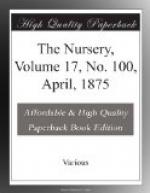Arthur thought it very strange. Then, pointing to another picture, he said, “What’s this, Uncle Oscar?”
[Illustration: BARLEY.]
“That, Arthur, is a picture of barley as it grows in the field. It yields a very useful kind of grain. You have eaten it in soup, and also boiled. Stripped of the husk, and rounded and polished in a mill, the grains are pearly white; and then they are known as pearl-barley.”
“Here’s another picture, Uncle Oscar.”
“Did you ever eat rye-bread, Arthur?”
“Why, yes, Uncle Oscar! we had it for breakfast.”
Well, here is a picture of rye as it grows in the field. It is one of the best of grain-bearing grasses. It will grow where the weather is very cold. The straw is often worth almost as much as the grain.
[Illustration: RYE.]
“Rye grows on poor, light soils, which are altogether unfit for the wheat out of which we make our white bread. Sometimes we mix rye-flour with wheaten-flour, or with corn-meal, and so get a very good kind of bread.”
“Can I plant some flax-seed, and barley, and rye?” asked Arthur.
“Yes, my boy,” said Uncle Oscar. “You shall have some to plant in your garden next May. I think you will be pleased with the flax-plant, because of its pretty blue-flower.”
THE HARE WHO COULDN’T WAIT.
“There goes a hare,”
said Johnny to Max,
“Come, let us catch
him: here are his tracks!”
But, while they were talking
so wisely about it,
And Johnny was saying “We’ll
have him; don’t doubt it,”
Behind them the hare, with
a jump and a spring,
Ran swift as a swallow could
dart on the wing;
And Max and Johnny looked
round too late,
While his speed said, “Excuse
me, but I can’t wait.”
THE DRAWING-LESSON.
We give here another outline from Landseer for our little readers to copy. Perhaps they would like to know something about Sir Edwin Landseer. He was born in London, in 1803, and died less than two years ago.
He belonged to a family of artists. His father and elder brother were skilful engravers. His brother Charles earned high rank as a painter. But Edwin was the most famous of them all.
While yet a child, no bigger than some of the young-readers of “The Nursery,” he showed a great taste for drawing. He had an especial fondness for drawing animals. His father encouraged him by giving him pictures to copy; and soon his skill in copying became so great that his father took him into the fields, and taught him to draw animals from life.
In this way he soon acquired correct notions of color; and, at the age of fourteen, he began to attract attention by his spirited paintings of dogs, horses, and other animals. He continued to improve until he became one of the most celebrated artists of his day. In 1850, he was knighted by Queen Victoria, that is to say, he received the honorary title of Sir Edwin Landseer.




